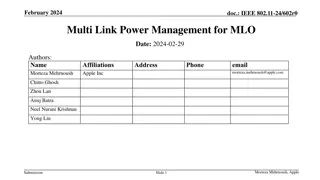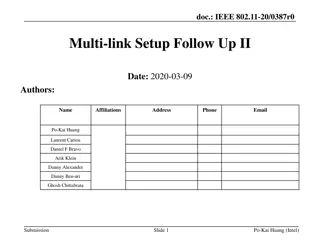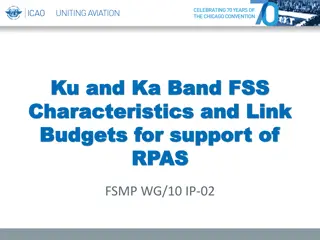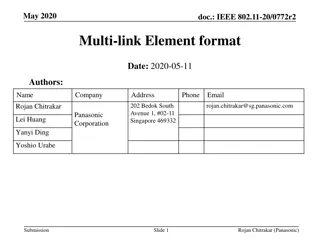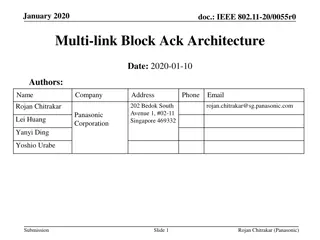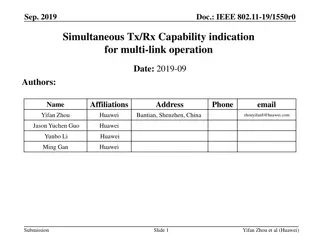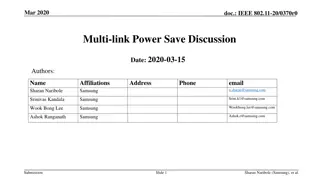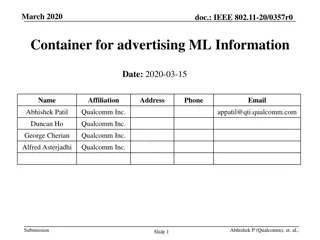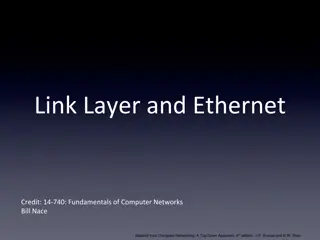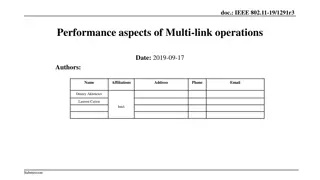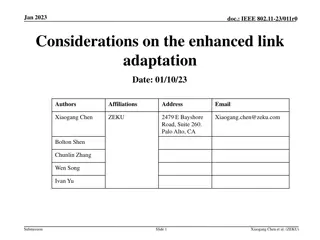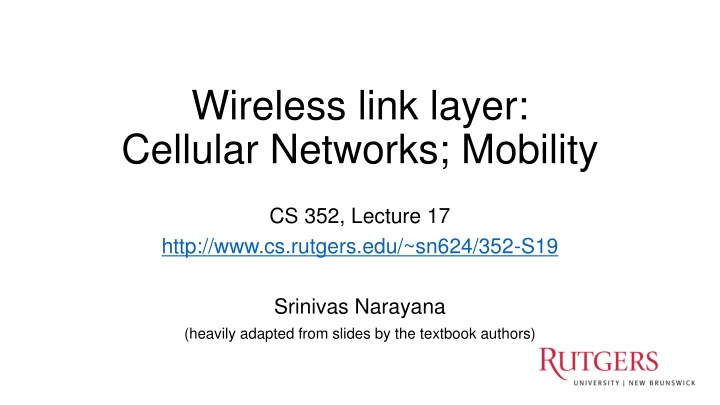
Cellular Networks and Wireless Link Layer Principles
Discover the intricacies of cellular networks and wireless link layer technologies in this insightful lecture. Explore topics such as signal attenuation, hidden terminal problems, and medium access control. Dive into the architecture and operation of 2G, 3G, 4G, and 5G networks, including components like Base Stations and Mobile Switching Centers. Learn about spectrum sharing techniques like FDMA/TDMA and CDMA, as well as the evolution of voice and data network architectures in 2G and 3G systems.
Download Presentation

Please find below an Image/Link to download the presentation.
The content on the website is provided AS IS for your information and personal use only. It may not be sold, licensed, or shared on other websites without obtaining consent from the author. If you encounter any issues during the download, it is possible that the publisher has removed the file from their server.
You are allowed to download the files provided on this website for personal or commercial use, subject to the condition that they are used lawfully. All files are the property of their respective owners.
The content on the website is provided AS IS for your information and personal use only. It may not be sold, licensed, or shared on other websites without obtaining consent from the author.
E N D
Presentation Transcript
Wireless link layer: Cellular Networks; Mobility CS 352, Lecture 17 http://www.cs.rutgers.edu/~sn624/352-S19 Srinivas Narayana (heavily adapted from slides by the textbook authors) 1
Review: The wireless link layer Wireless medium is very different from wired Signal attenuation ( fading ) much more important to handle Hidden terminal problem Consequences of differences: Link-layer ACKs Transmission delays to control contention: SIFS, DIFS Link reservation (RTS/CTS) Medium access control Frequency division multiple access (AP channels in WiFi) Random access (CSMA/CA for transmitting to/from WiFi AP) Code division multiple access (simultaneous transmission in cellular networks) 2
Cellular networks: Overview 2G, 3G, 4G, 5G
Components of cellular network architecture MSC connects cells to wired tel. net. manages call setup (more later!) handles mobility (more later!) cell covers geographical region base station (BS) analogous to 802.11 AP mobile users attach to network through BS air-interface: physical and link layer protocol between mobile and BS Mobile Switching Center Public telephone network Mobile Switching Center wired network 4
Cellular networks: the first hop Two techniques for sharing mobile-to-BS radio spectrum combined FDMA/TDMA: divide spectrum in frequency channels, divide each channel into time slots CDMA: code division multiple access time slots frequency bands 5
2G (voice) network architecture Base station system (BSS) MSC G BTS BSC Public telephone network Gateway MSC Legend Base transceiver station (BTS) Base station controller (BSC) Mobile Switching Center (MSC) Mobile subscribers 6
3G (voice+data) network architecture MSC G Public telephone network radio network controller Gateway MSC G Public Internet SGSN Key insight: new cellular data network operates in parallel (except at edge) with existing cellular voice network voice network unchanged in core data network operates in parallel GGSN Serving GPRS Support Node (SGSN) Gateway GPRS Support Node (GGSN) 7
3G (voice+data) network architecture MSC G Public telephone network radio network controller Gateway MSC G Public Internet SGSN GGSN radio interface (WCDMA, HSPA) core network General Packet Radio Service (GPRS) Core Network public Internet radio access network Universal Terrestrial Radio Access Network (UTRAN) 8
3G versus 4G LTE network architecture MSC G Public telephone network radio network controller Gateway MSC 3G G Public Internet SGSN GGSN HSS 4G-LTE MME G G Public Internet S-GW P-GW radio access network Universal Terrestrial Radio Access Network (UTRAN) Evolved Packet Core (EPC) 9
4G: differences from 3G all IP core: IP packets tunneled (through core IP network) from base station to gateway no separation between voice and data all traffic carried over IP core to gateway Mobility Management Entity (MME) Home Subscriber Server(HSS) (like HLR+VLR) Packet data network Gateway (P-GW) Serving Gateway (S-GW) UE eNodeB (base station) HSS (user element) MME G G Public Internet data S-GW P-GW radio access network Universal Terrestrial Radio Access Network (UTRAN) Evolved Packet Core (EPC) 10
5G: the next generation Goal: higher data rates, lower delays Enabled by better transmission technology (you don t need to know what these terms mean:) Multiple input multiple output antennas New radio frequency bands Beamforming To support novel applications IoTs, edge networking, SDN, NFV,
Mobility How do hosts move and still retain network connectivity?
What is mobility? spectrum of mobility, from the network perspective: no mobility high mobility mobile wireless user, using same access point mobile user, passing through multiple access point while maintaining ongoing connections (like cell phone) mobile user, connecting/ disconnecting from network using DHCP. 13
Questions: IP addresses and routing An IP address refers to the point of attachment of a host to a network So, when a host moves, should its IP address change? What is the impact on the higher layers of the protocol stack? How will remote hosts reach (route to) the mobile host? New connections? Ongoing connections?
How do you contact a mobile friend: Consider friend frequently changing addresses, how do you find her? I wonder where Alice moved to? search all phone books? call her parents? expect her to let you know where he/she is? Facebook! 15
Mobility: vocabulary home network: permanent home of mobile (e.g., 128.119.40/24) home agent: entity that will perform mobility functions on behalf of mobile, when mobile is remote wide area network permanent address: address in home network, can always be used to reach mobile e.g., 128.119.40.186 16
Mobility: more vocabulary visited network: network in which mobile currently resides (e.g., 79.129.13/24) permanent address: remains constant (e.g., 128.119.40.186) care-of-address: address in visited network. (e.g., 79,129.13.2) wide area network foreign agent: entity in visited network that performs mobility functions on behalf of mobile. correspondent: wants to communicate with mobile 17
Mobility: approaches let routing handle it: routers advertise permanent address of mobile-nodes-in-residence via usual routing table exchange. routing tables indicate where each mobile located no changes to end-systems let end-systems handle it: indirect routing: communication from correspondent to mobile goes through home agent, then forwarded to remote direct routing: correspondent gets foreign address of mobile, sends directly to mobile 18
Mobility: approaches let routing handle it: routers advertise permanent address of mobile-nodes-in-residence via usual routing table exchange. routing tables indicate where each mobile located no changes to end-systems let end-systems handle it: indirect routing: communication from correspondent to mobile goes through home agent, then forwarded to remote direct routing: correspondent gets foreign address of mobile, sends directly to mobile not scalable to millions of mobiles 19
Mobility: registration visited network home network 1 2 wide area network mobile contacts foreign agent on entering visited network foreign agent contacts home agent home: this mobile is resident in my network end result: foreign agent knows about mobile home agent knows location of mobile 20
Mobility via indirect routing foreign agent receives packets, forwards to mobile home agent intercepts packets, forwards to foreign agent visited network home network 3 wide area network 2 1 4 correspondent addresses packets using home address of mobile mobile replies directly to correspondent 21
Mobile IP: indirect routing foreign-agent-to-mobile packet packet sent by home agent to foreign agent: a packet within a packet dest: 128.119.40.186 dest: 79.129.13.2 dest: 128.119.40.186 Permanent address: 128.119.40.186 Care-of address: 79.129.13.2 dest: 128.119.40.186 packet sent by correspondent Wireless and Mobile Networks 7-22
Indirect Routing: comments mobile uses two addresses: permanent address: used by correspondent (hence mobile location is transparent to correspondent) care-of-address: used by home agent to forward datagrams to mobile foreign agent functions may be done by mobile itself triangle routing: correspondent-home-network- mobile inefficient when correspondent, mobile are in same network 23
Indirect routing: moving between networks suppose mobile user moves to another network registers with new foreign agent new foreign agent registers with home agent home agent update care-of-address for mobile packets continue to be forwarded to mobile (but with new care-of-address) mobility, changing foreign networks transparent: on going connections can be maintained! 24
Mobility via direct routing foreign agent receives packets, forwards to mobile correspondent forwards to foreign agent visited network home network 3 2 1 4 mobile replies directly to correspondent correspondent requests, receives foreign address of mobile 25
Mobility via direct routing: comments overcome triangle routing problem non-transparent to correspondent: correspondent must get care-of-address from home agent what if mobile changes visited network? 3 2 1 4 26
Accommodating mobility with direct routing anchor foreign agent: FA in first visited network data always routed first to anchor FA when mobile moves: new FA arranges to have data forwarded from old FA (chaining) foreign net visited at session start anchor foreign agent wide area network 2 1 4 3 5 new foreign network correspondent agent new foreign agent correspondent 27
Real implementations of mobility (1) Mobile IP: an extension to the IP protocol for mobility RFC 3344 Uses indirect routing + packet encapsulation Registration protocol for home agent when mobile visits a different net Agent discovery to let home agent know about foreign agent
Real implementations of mobility (2) Cellular network handoff Can change base station associated with your phone due to better signal strength, load shedding, and yes, mobility :) Handoff between base stations uses indirect routing Lots of resources set up to ensure calls don t get dropped Corresponding overheads Handoff between multiple Mobile Switching Stations (MSCs) Anchor MSC from the first visited MSC Chain of MSCs forwards packets
Impact of mobility on higher- layer protocols
Wireless, mobility: impact on higher layer protocols logically, impact shouldbe minimal best effort service model remains unchanged TCP and UDP can (and do) run over wireless, mobile but performance-wise: packet loss/delay due to bit-errors (discarded packets, delays for link-layer retransmissions), and handoff TCP interprets loss as congestion, will decrease congestion window un-necessarily delay impairments for real-time traffic limited bandwidth of wireless links 31
Synthesis: a day in the life of a web request Our journey down protocol stack complete! application, transport, network, link putting-it-all-together: synthesis! goal: identify, review, understand protocols (at all layers) involved in seemingly simple scenario: requesting www page scenario: student attaches laptop to campus network, requests/receives www.google.com 33
A day in the life: scenario DNS server browser Comcast network 68.80.0.0/13 school network 68.80.2.0/24 web page web server Google s network 64.233.160.0/19 64.233.169.105 34
A day in the life connecting to the Internet connecting laptop needs to get its own IP address, addr of first- hop router, addr of DNS server: use DHCP DHCP UDP IP Eth Phy DHCP DHCP DHCP DHCP DHCP DHCP request encapsulated in UDP, encapsulated in IP, encapsulated in 802.3 Ethernet DHCP UDP IP Eth Phy DHCP DHCP DHCP DHCP router (runs DHCP) DHCP Ethernet frame broadcast (dest: FFFFFFFFFFFF) on LAN, received at router running DHCP server Ethernet demuxed to IP demuxed, UDP demuxed to DHCP 35
A day in the life connecting to the Internet DHCP UDP IP Eth Phy DHCP server formulates DHCP ACK containing client s IP address, IP address of first-hop router for client, name & IP address of DNS server DHCP DHCP DHCP DHCP encapsulation at DHCP server, frame forwarded (switch learning) through LAN, demultiplexing at client DHCP UDP IP Eth Phy DHCP DHCP DHCP router (runs DHCP) DHCP DHCP client receives DHCP ACK reply DHCP Client now has IP address, knows name & addr of DNS server, IP address of its first-hop router 36
A day in the life ARP (before DNS, before HTTP) before sending HTTPrequest, need IP address of www.google.com: DNS DNS UDP IP Eth Phy DNS DNS DNS ARP ARP query DNS query created, encapsulated in UDP, encapsulated in IP, encapsulated in Eth. To send frame to router, need MAC address of router interface: ARP ARP Eth Phy ARP reply ARP query broadcast, received by router, which replies with ARP reply giving MAC address of router interface router (runs DHCP) client now knows MAC address of first hop router, so can now send frame containing DNS query 37
A day in the life using DNS DNS UDP IP Eth Phy DNS server DNS DNS DNS UDP IP Eth Phy DNS DNS DNS DNS DNS DNS DNS Comcast network 68.80.0.0/13 IP datagram forwarded from campus network into Comcast network, routed (tables created by RIP, OSPF, IS-IS and/or BGP routing protocols) to DNS server router (runs DHCP) IP datagram containing DNS query forwarded via LAN switch from client to 1st hop router demuxed to DNS server DNS server replies to client with IP address of www.google.com 38
A day in the lifeTCP connection carrying HTTP HTTP HTTP TCP IP Eth Phy SYNACK SYN SYN SYNACK SYNACK SYN SYN to send HTTP request, client first opens TCP socket to web server router (runs DHCP) TCP SYN segment (step 1 in 3-way handshake) inter-domain routed to web server web server responds with TCP SYNACK (step 2 in 3-way handshake) TCP IP Eth Phy SYNACK SYN SYN SYNACK SYNACK SYNACK SYN web server 64.233.169.105 TCP connection established! 39
A day in the life HTTP request/reply web page finally (!!!) displayed HTTP HTTP HTTP TCP IP Eth Phy HTTP HTTP HTTP HTTP HTTP HTTP HTTP HTTP request sent into TCP socket IP datagram containing HTTP request routed to www.google.com web server responds with HTTP reply (containing web page) router (runs DHCP) HTTP TCP IP Eth Phy HTTP HTTP HTTP HTTP HTTP web server IP datagram containing HTTP reply routed back to client 64.233.169.105 40

